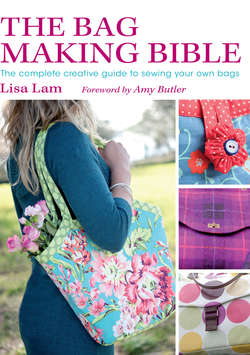Читать книгу The Bag Making Bible - Lisa Lam - Страница 6
На сайте Литреса книга снята с продажи.
ОглавлениеBasic Equipment
If you already enjoy sewing as a hobby, the chances are you already have most of the essential equipment for bag making. As with most things you get what you pay for, so buy the best you can afford and you’ll need to replace items less often.
Cutting
• Rotary cutter – a rotary cutter greatly increases the speed and accuracy of fabric cutting. Also look out for rotary blade sharpeners, which will save you money on replacing dull blades.
• Cutting mat – for use with a rotary cutter. Choose one that has both imperial and metric gridlines (inches and centimetres). The gridlines are also really helpful when drafting your own bag patterns.
• Dressmaking scissors – choose scissors that cut all the way through to the tip, are as heavy as is comfortable (as the weight aids cutting stability), and are angled with the handles raised upwards.
• Embroidery scissors – small, fine-pointed scissors are essential for precision snipping.
• Seam ripper – not just for unpicking seams, a seam ripper is perfect for making tiny incisions for magnetic snaps and buttonholes. Always replace dull seam rippers to prevent you from having to push too hard, which could result in slipping.
Marking, measuring and pinning
• Disappearing marker – this is my favourite type of marker because it is more precise than chalk. Make your marks as desired and they will disappear within 48 hours. Always do a test on a small swatch of your fabric to check first.
• Hera marker (or bone folder) – this useful marker makes an indent in your fabric from pressure only, so it is perfect if your fabric is unsuitable for a disappearing marker. It is also great for pre-creasing fabric when you need to make folds or pleats.
• Tape measure – to make measurement conversions easier, choose a tape measure with both metric and imperial measurements printed on the same side.
• Sewing pins – I love flower flathead pins because they are pretty and they prevent sore fingertips, sometimes caused by pushing pins through lots of layers.
• Hand-sewing needle – although you will be mostly sewing by machine, there are times when hand sewing is unavoidable – such as when the sewing machine can’t reach the areas you need to stitch, or when sewing on buttons for example.
Bag-making tools
None of these tools are exotic or hard to obtain. They are all simple tools, which over the years I have collected. To make life easier and to get the best results from your bag making, try adding these items to your tool kit.
Tape maker I use 2.5cm (1in) and 5cm (2in) tape makers to make bias tape for my own pretty piping and binding. See Making Your Own Bias Binding.
Bodkin A bodkin is used for speedy threading of cord or elastic through fabric tubes or casings. Attach the cord/elastic to the bodkin and thread the bodkin through your fabric tube.
Fabric glue Use good-quality clear-drying fabric glue for when sewing isn’t an option. Good fabric glue can be just as effective as stitching.
Mini bulldog clips Use these strong clips to hold pieces of fabric together temporarily when sewing pins are unsuitable, such as when your layers are very thick.
Thread For ease of use and to make long-lasting bags, use good quality all-purpose polyester thread. It might be tempting to buy cheaper thread but this breaks more easily, which makes it unsuitable for bag making.
Loop turner This simple tool is used for turning fabric tubes the right way out for speedy fabric strap making.
Hammer and pliers Use a small hammer when you are working with rivets and eyelets (see Eyelets and Rivets). Use two pairs of pliers for opening and closing metal rings and links in purse chains. Jewellery pliers are especially suited to those with small hands.
Tailors awl An awl is useful for making holes in fabric for rivets, poking out corners in fine straps (when turning out), or even coaxing small parts of your bag underneath the sewing machine foot (to help the feed dogs grab the fabric). Two types are available; one with a sharp point; the other with a ballpoint tip.
Hole punch Use a hole punch to cut neat holes in fabric for eyelets or popper snaps. This hole punch has various sized hole-cutter attachments and a smaller grip, which is great for small hands.
